The Crimean war has been reviewed numerous times from different points of view, including conspiratorial ones. Nevertheless, this event is still one of the most mysterious ones in our nation’s history. The name itself reveals that it took place in Crimea, stressing that this location was the main battlefield of the war. However, we know that some military operations were conducted by the very same belligerents in Baltic, White and Okhotsks seas as well. There were also some less known battles such as bombing of Odessa, Taganrog, Suomenlinna (Sveaborg), which left almost no trace in history. Long story short – the Crimean War was a conflict of a much bigger scalce than just a single Crimea-related operation.
This banner was captured during the Siege of Petropavlovsk, an event that some prefer to avoid speaking about. The siege resulted in Russian forces’ victory, but there was something more to this battle than it seems at a first glance. Look attentively at the Allied forces’ banner, does the logo seem familiar to you? Either way, the prevailing international force lost that day, and it was an embarrassing defeat for them.
Speaking of this international (or allied) force, old images related to this matter depict ships with flags of various nations, besides England and France (that fought together against Russia during the Siege of Petropavlovsk). What could unite all those different nations, given the fact that some of them even fought against each other for decades? This situation resembles the ongoing events in Syria, where alliances can be compared to tram’s passengers that all move towards a common goal. It all revolves around short-term or long-term mutual goals of participating parties. In our case, one of the key factors (or goals if I may say so) that unites the parties of the before-mentioned international force is a territory of a former nation, that had entered a crisis, as well as division and securing of this territory’s resources. But what was that unknown crisis that struck Russia’s territory in the middle of the 19th century?
Returning to Crimean territory and its role in the overall military conflict, it should be stated that the courage of people that defended Sevastopol and intensity of related battles were the main reasons why this conflict made such a high historical impact. Sevastopol, by the way, was not the only city that served as a fighting ground in the conflict. Before allied forces entered Azov Sea, they had to pass through Kerch Fortress. According to official history, fortress guards that were located there didn’t hinder allied forces from passing through Kerch Strait, thus opting out of armed conflict. However, the story that surrounds this event is quite vague and mysterious, particularly due to the fact that the southern part of the Kerch Fortress has traces of destruction, by a weapon that is clearly more powerful than those that were available at those times. Some parts of the fortress’ wall are literally ground off by a giant cutter. So, apparently, official history has a completely wrong perception of those events and there might have been something that let the allied forces pass through this checkpoint so easily. Historians are surely not interested in such unfitting facts.
Curious facts show up when you inspect Crimean War medals.
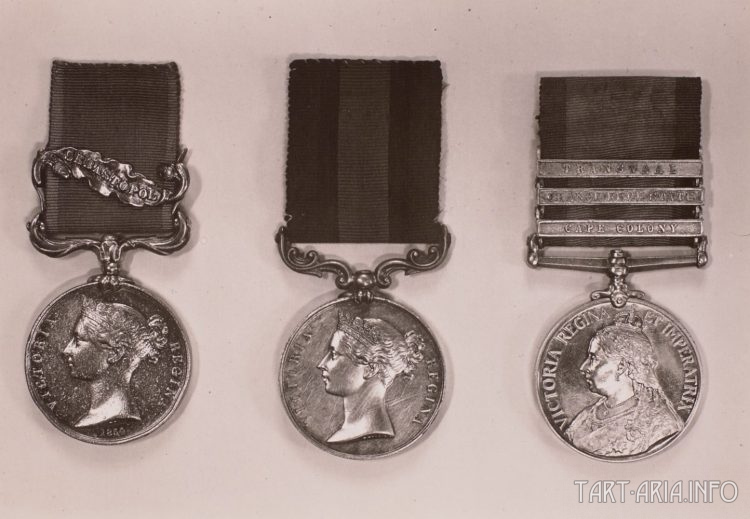
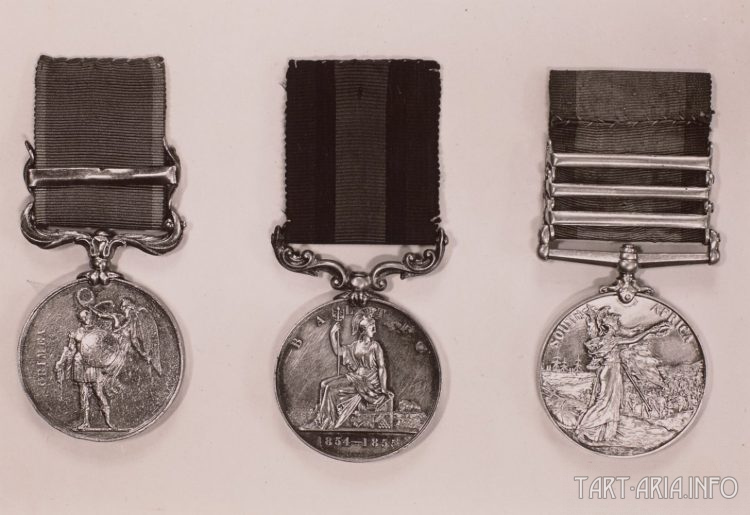
Here is a collection of Crimean War medals taken from some foreign exposition. The left one is for victory in Sevastopol, which is clear. The one in the center is for victory in Baltics, but which exactly? Could it be for Sveaborg? Or maybe Saint-Petersburg was captured or somehow forced to capitulate? The question remains unanswered. While the oddest thing here is that in the same row we see a medal for victory in South Africa, with aged queen Victoria on the coin’s reverse. The corresponding events in South Africa happened later than Crimean War for sure. What could unite South Africa and Russian Empire? It reminds me of an old song about Transvaal Republic and Boer War, which took place in South Africa at the end of the 19th century.
If you look at the whole 19th century and even the first decade of the 20th century you’ll see that it is full of odd military conflicts and weird natural disasters that were happening all over the world (probably except Antarctic). In the United States, for instance, those events (natural disasters) have been labelled as fires or earthquakes. The usual outcome of these disasters were destroyed cities. However, the scale of destruction left by those “fires” looks so devastating that it makes you think it was caused by a nuclear weapon (or by some other force of similar strength). All these facts hint at an idea that some force (or entities) was clearing the whole planet from of old civilization’s remnants. Later on, historians had to cover it up by calling those events wars or earthquakes, because it was impossible to hide it completely. The Crimean War is not exception and apparently was just a part of a much larger global conflict of that time. What was the reason of this global clean-up?
At this point, let’s dive deeper into the Crimean War, particularly into extant historical evidences. Luckily for us, some digital archives haven’t been censored yet, so we have a chance to see some curious details.
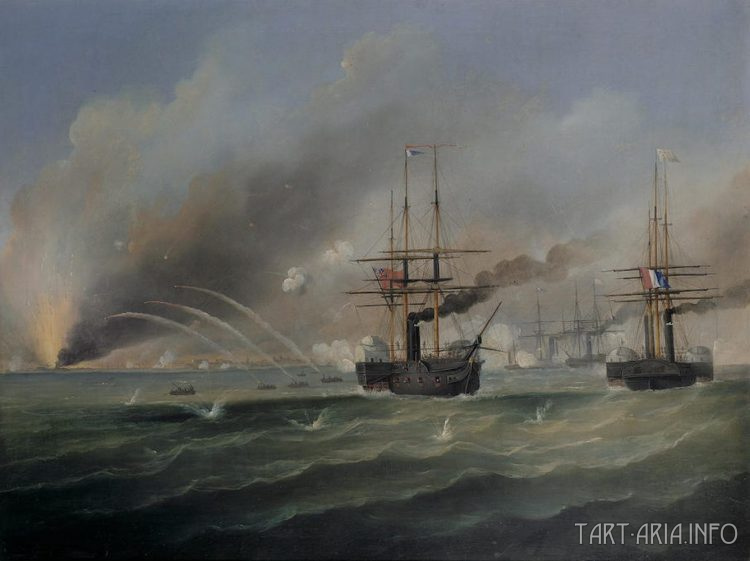
This one is a common painting of those times which depicts bombarding of Odessa on April 22nd 1854. There is a great variety of similar paintings freely available on the internet, even including those that depict torus-shaped vortices. But now let’s talk about something else. Take a close look at the encircled fragments of the painting.
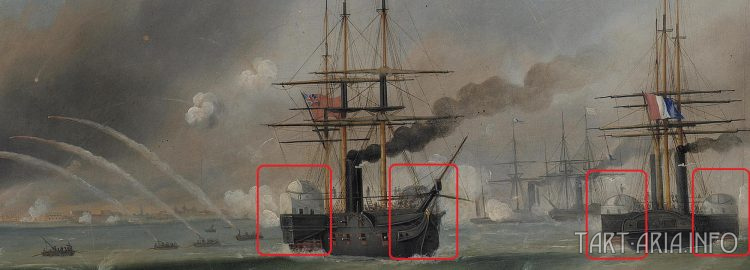
Why do you think a steam-ship like this would need masts with sails? Looks very odd. Equally odd look the dome-shaped units on the sides of both ships. What was their purpose? They were not coal storages for sure, because a voyage from England to Crimea would take much more coal than those two storages could contain. Another question is – how did these fairly small gunboats cause such destruction with their weaponry on long distances? I assume that paintings like this are not original, they were either painted in the early 20th century or copied from some older paintings with removal or retouching of crucial details.
Now let’s move to heroic Sevastopol. Much have been told about this city as well as about the Siege of it, which lasted almost a year (1854-1855).
Excerpt from Wikipedia:
"The siege of Sevastopol (at the time called in English the siege of Sebastopol) lasted from October 1854 until September 1855, during the Crimean War. The allies (French, Sardinia, Ottoman, and British) landed at Eupatoria on 14 September 1854, intending to make a triumphal march to Sevastopol, the capital of the Crimea, with 50,000 men. The 56-kilometre (35 mi) traverse took a year of fighting against the Russians. Major battles along the way were Alma (September 1854), Balaklava (October 1854), Inkerman (November 1854), Tchernaya (August 1855), Redan (September 1855), and, finally, Malakoff (September 1855). During the siege, the allied navy undertook six bombardments of the capital, on 17 October 1854; and on 9 April, 6 June, 17 June, 17 August, and 5 September 1855. Sevastopol is one of the classic sieges of all time.[9] The city of Sevastopol was the home of the Tsar's Black Sea Fleet, which threatened the Mediterranean. The Russian field army withdrew before the allies could encircle it. The siege was the culminating struggle for the strategic Russian port in 1854–55 and was the final episode in the Crimean War."
Why would the enemy so eagerly want to capture Sevastopol, while leaving other Russian cities of Azov-Blacksea region only with bombardments? The answer is obvious – Sevastopol was headquarters of Russia’s Black Sea Navy Fleet, where all main naval facilities were located. Destroying this headquarters would simple bring down Russia’s Fleet. It is hard to say why Sevastopol was chosen as a location of the main naval base. Feodosia, for instance, has the deepest nearshore waters in the area, which allow entrance of big oceanic ships. The base was probably inherited from a previous civilization (if I may say so), and it was pointless to move it elsewhere. Moreover, there were no need in ships of bigger tonnage at that time.
By the way, cities of Odessa and Sevastopol got their names by the will of Catherine the Great (Catherine II). These names were taken from some other cities that used to exist somewhere and disappeared during mysterious events. Their original names are lost in history.
Let’s imagine a situation where the allied forces managed to destroy russian fleet by just damaging Sevastopol’s base. The task could be considered completed and Russia wouldn’t be able to restore its Black Sea fleet, as it had been planned originally. Another option could be taking the city and turning it into something similar to Hong-Kong or any other colonial city of that time. But none of the above mentioned was done. The allied forces just destroyed Sevastopol, and did it at a high price. Turns out they were not interested neither in keeping the base nor in destroying the fleet. The key to this entire situation was hidden somewhere inside the city itself. One side struggled to defend it while the other eagerly wanted to capture it and destroy. When Sevastopol eventually got destroyed, it lost its value to the allied forces. Could that hidden key be related to energy technologies of the past?
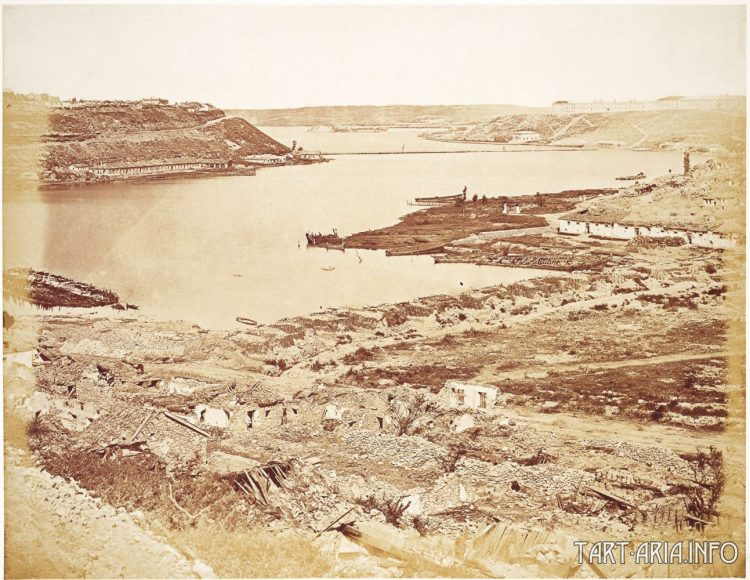
This is how Sevasotopol officially looked on September 12th 1855. The photo was taken by James Robertson, an English photographer. You can see more similar photos of this photographer here. Indeed, the city lost any strategical meaning at this point, there were almost no intact structures left. Even Strasbourg and Paris looked better after being bombed in 1870-1871. Sevastopol by contrast looks like Hiroshima in 1945. What secrets did Sevastopol keep?
It would be wise to start with weapons that could have been used to turn the city into ruins. According to official history, the city was being simultaneously bombarded from land and sea, using up to 800 canons. It must be assumed that those cannons shot cannonballs.
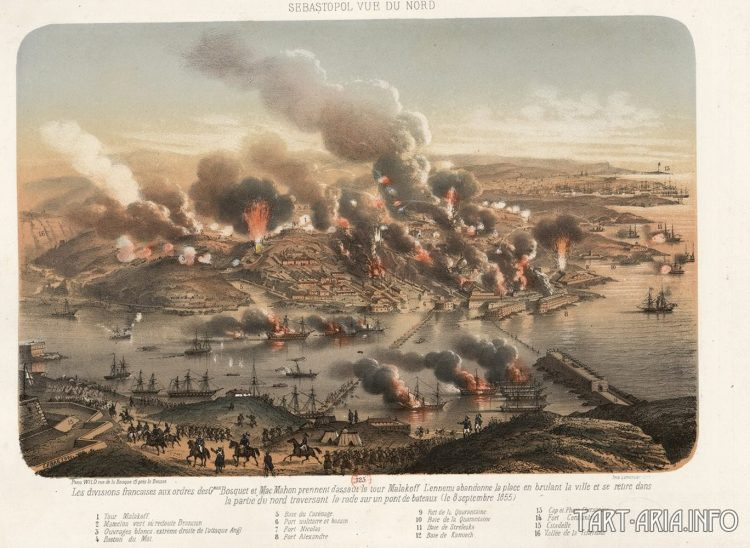
The image above represents rough look of those cannons in action. You can find bunch of similar images on the internet. However, you can notice that the city look not the way we saw it in the photos of J. Robertson. The streets and buildings are almost intact. Malakoff redoubt is in smoke but it doesn’t mean anything, since the smoke is covering the whole city. It is also possible that such images were made of real photos, by taking a background and adding some details.
If this image was made of real photo, then where was the photographer standing? It was northern side of the bay. It is believed that the last surviving defenders of the city were evacuated there. So it turns out that the main attack on the city started from the southern side. Attack from north was hindered by the bay or some other reasons.
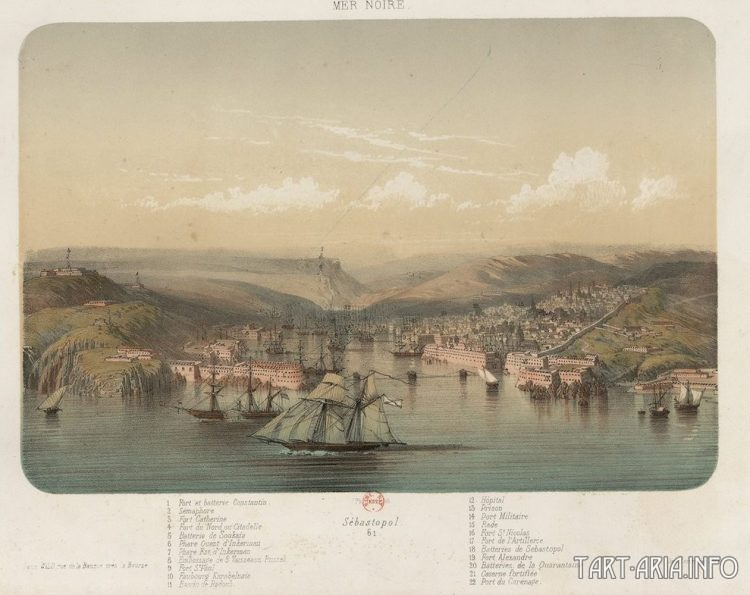
Indeed, the northern side (on the left side of the image) was not suitable for ground-based combat and northern fort was located there. Previously, this place used to be called – “Telegraph mountain”. It is believed that at the beginning of the war an optical telegraph used to stand there. But with whom did they communicate with it? And why was it valuable amidst combat actions?
All these questions would probably remain unanswered if we weren’t able to access digital archives with uncensored content. Thanks to them, 19th century Sevastopol reveals its curious details.
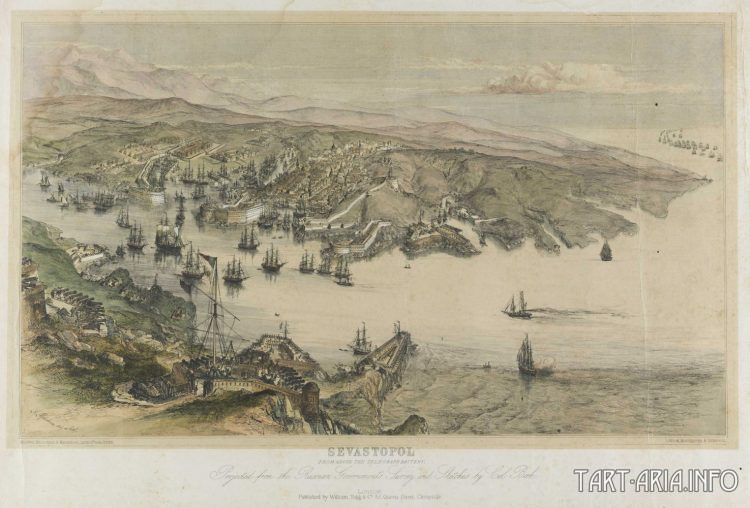
This print of unknown date and author was probably made before the Crimean war. At least we can’t see any traces of destruction. It is titled: “Sevastopol. From above the telegraph battery”. Telegraph battery is the very telegraph mountain or the northern telegraph fort that I mentioned previously. The images indeed depict some towering pillar above fort. How does it look nowadays?
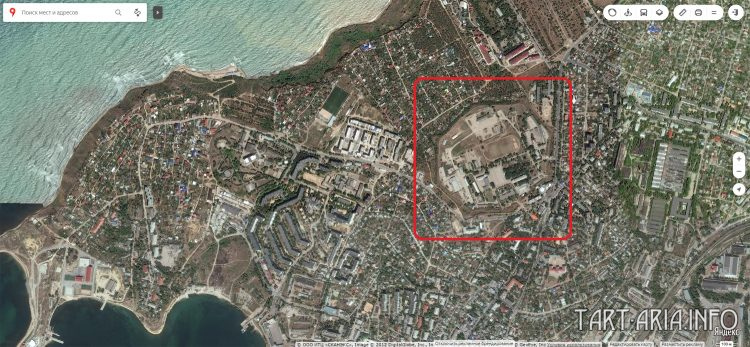
Only remains of the previously existing fort can be found nowadays there.
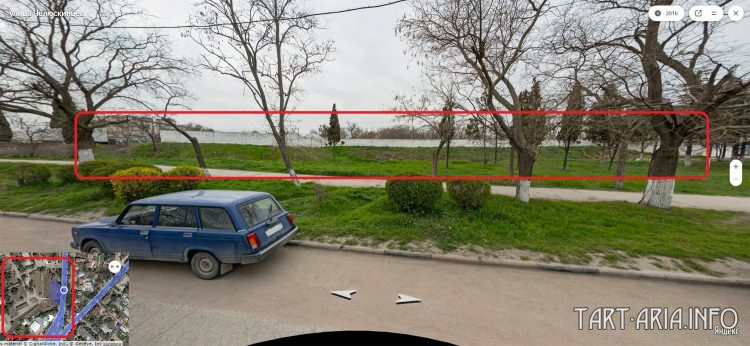
However, at those times, all-round view of Sevastopol from this point was apparently beautiful. Let’s zoom in the print in some parts.
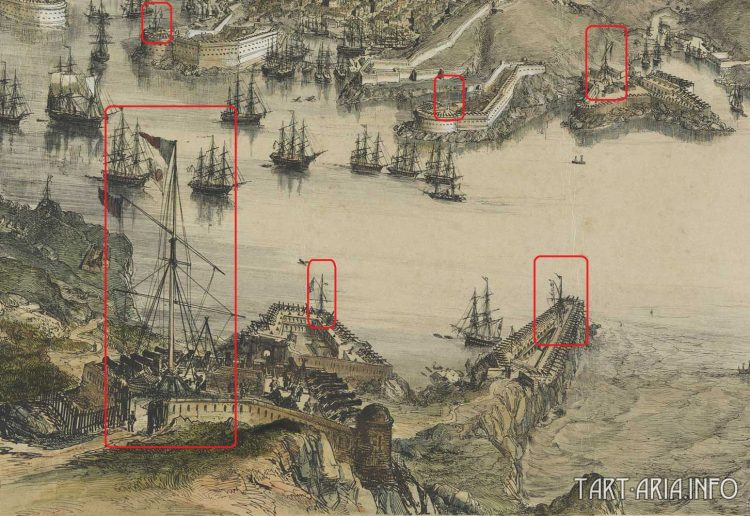
We can see that all forts have ship masts. What was their purpose? I recall a picture from one of my previous articles.
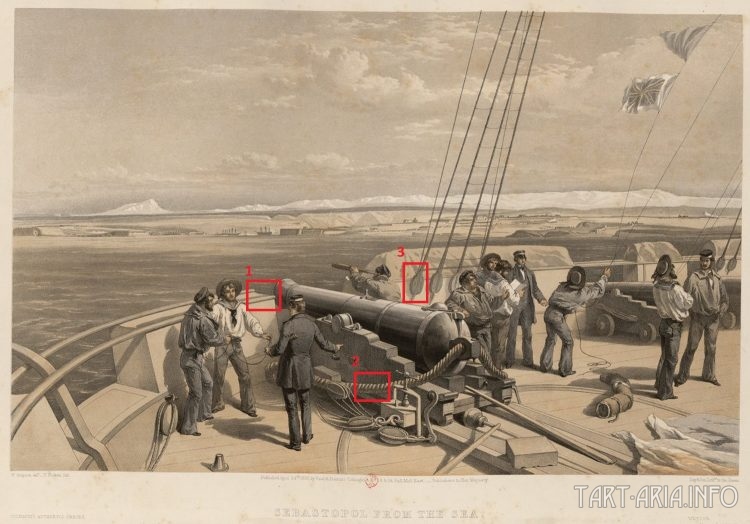
Some of you argued that it was a ship instead of a fort. Here, look at the image. You can see cables that run down from the masts that were seen in the previous picture. These cables are attached to insulator units (№3 in the image). All these elements formed an integral (energy) grid. The rope holded by those three soldiers (№1 in the image) is probably a wire (or an aiguillette) that could be connected that this grid. Counter-recoil hawser’s (№2 in the image) purpose is arguable, but given the visible tie-downs of the cannon, its presence is almost pointless. But if we consider that this hawser works like a wire that connects the gun to the grid or to some energy device that is located under the fort, then everything becomes clear. What could there be, under the fort?
At this point, we’ll have to make a little digression and recall one document from a previous article.
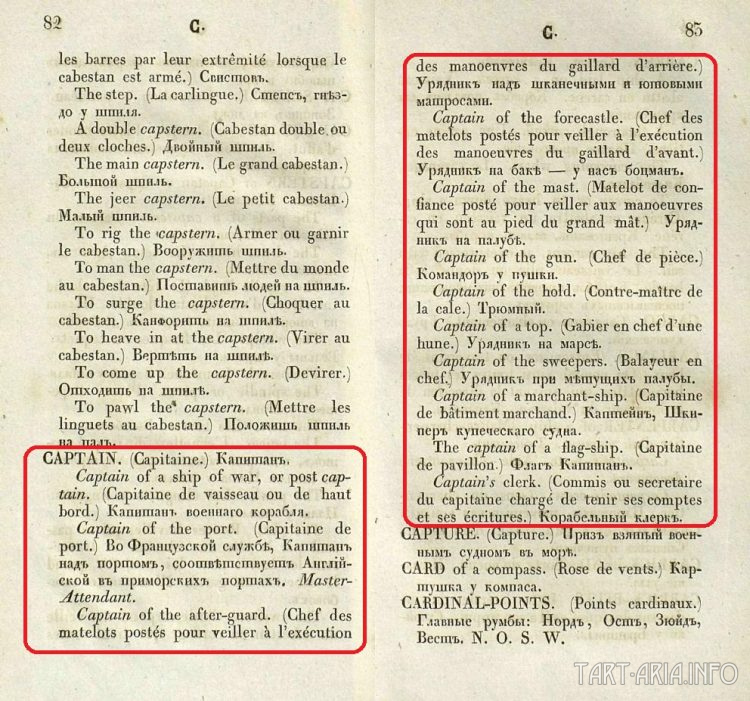
Why did they need a person called «captain of the port»? And why was this person called cap-tain in the first place? In Russian language this position is called uryadnik, derived from the word ряд (ryad) (eng: row). Literal translation would be – a person that stands near some row. So we may assume that this person was somehow responsible for a row of something and for its maintenance. Ряд(row)-ярд(yard)-ядро(core) – all these words apparently have the same roots/origin that explain similarities in different languages. What does it all mean? Let’s take a look at another image related to defense of Sevastopol.
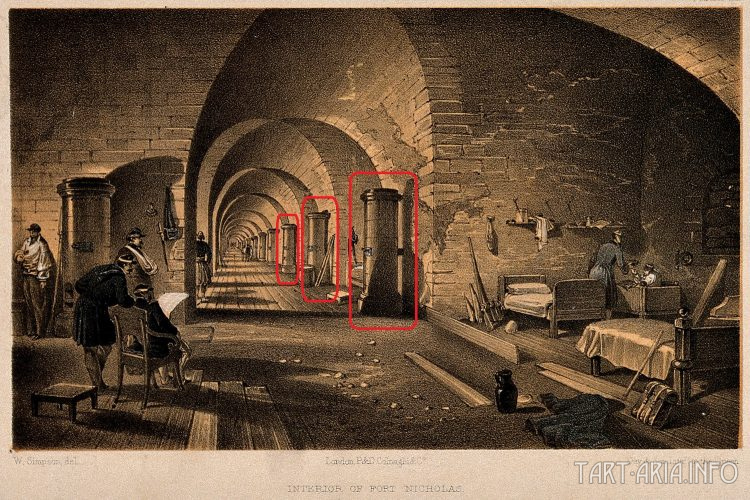
What are these furnaces standing inside Fort Nicholas? Did they really need to keep this place warm? In Crimea, in the open space? Of course not. These are those rows we talked previously about, rows (rus: ряды) that were maintained by captains (rus: урядники). These furnaces/generators accumulated the energy needed for the upstairs cannons to shoot. Little hatches on these furnaces were made solely for maintenance purposes, no fuel was put there. The charge they gathered used to go through metal frame that was hidden inside walls. By the way, in Kerch Fortress similar metal frame can be found, and it goes up to every former cannon spot (4 junction points at each spot). Additional joints were made either to amplify the weapon’s power or to have reserve power source. When these technologies went to oblivion, furnace-looking generators of special energy were easily turned into ordinary furnaces.
As you have probably guessed, Fort Nicholas is gone. Completely. Probably since 1855.
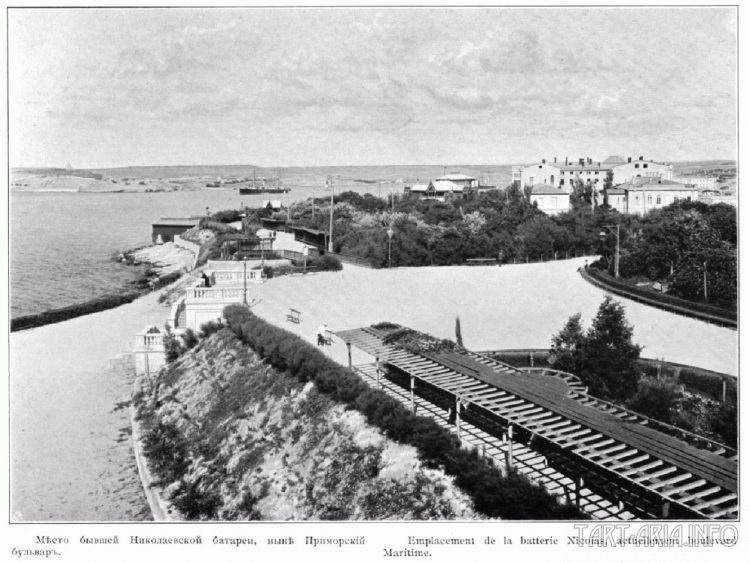
You have also probably guessed that cannons (used during the Crimean War) didn’t shoot cannonballs, and that weapons that completely destroyed Sevastopol were much more sophisticated. Just look at the scale of destruction:
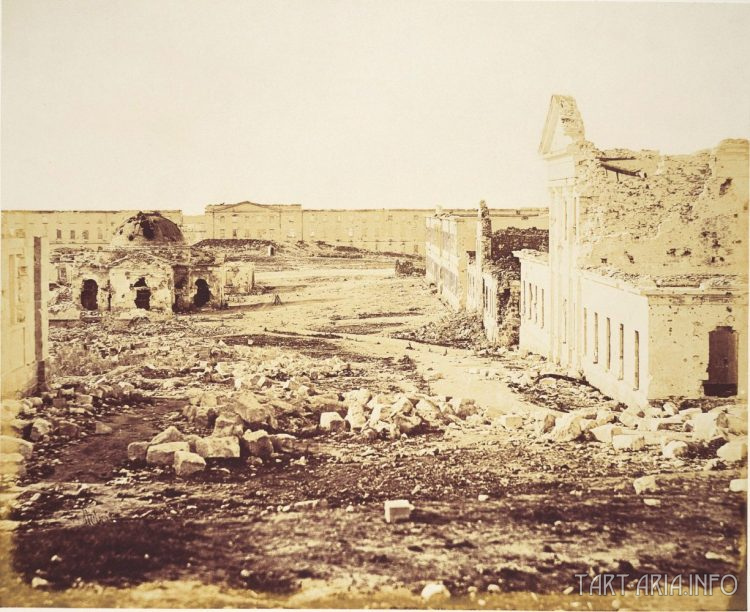
Projectiles of those weapons almost disintegrated stone bricks. The remaining bricks survived only because they were scattered by shock waves. You can only imagine what happened to human beings that were exposed to such devastating weapons. Courage of Sevastopol defenders indeed deserves highest remark.
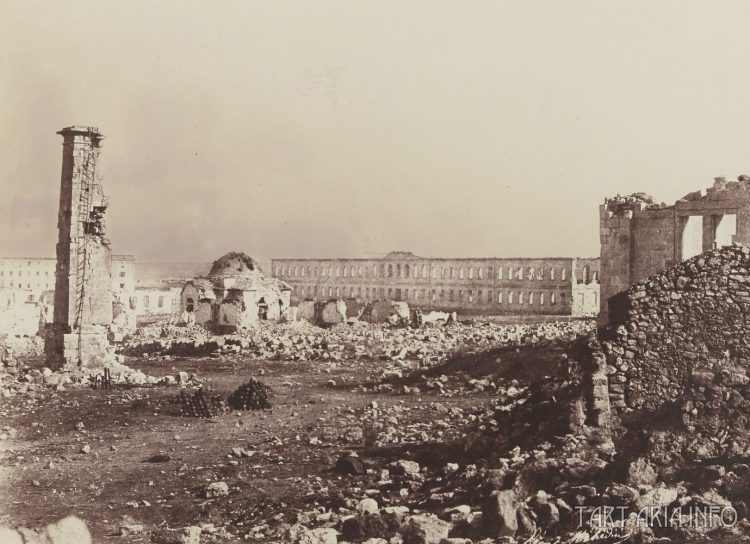
It should be noted that some of these photos are prearranged. Judging by the cannonballs (stacked together) and the lack of dead bodies.
As I have already written previously, during the clean-up of traces left from the previous civilization, everything related to technologies (and particularly weapons, that were used in Crimean War) was purposefully forgotten and hidden. Although, it worked on much simpler principles than modern weapons of mass destruction. During the Crimean War, one of the goals pursued by Allied Forces was to destroy such weapons that were in possession of their enemies. They reached their goal but with huge losses. Russian side did the same, but there are less historical evidences of allied forces’ destroyed ships (including those that were destroyed by advance weaponry).
The ships by the way had both masts and steam engines, but the masts were there not exactly for sails, or maybe even absolutely not for sails.
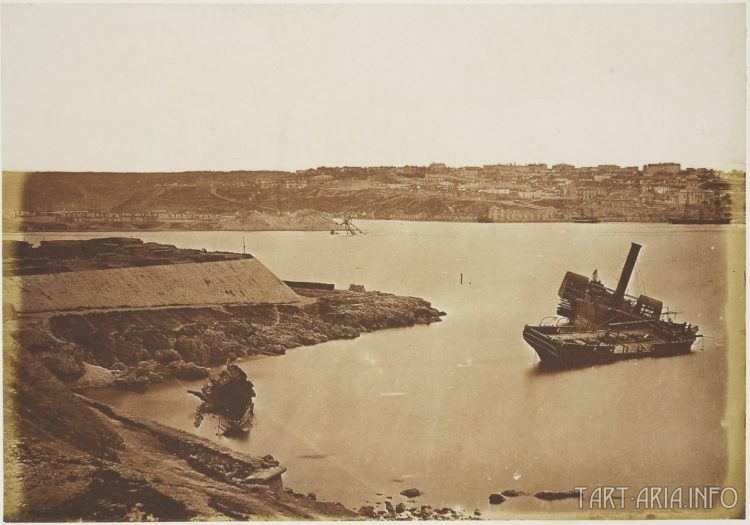
Sevastopol was defeated. Almost nothing remains of the forts and batteries that used to defend it.
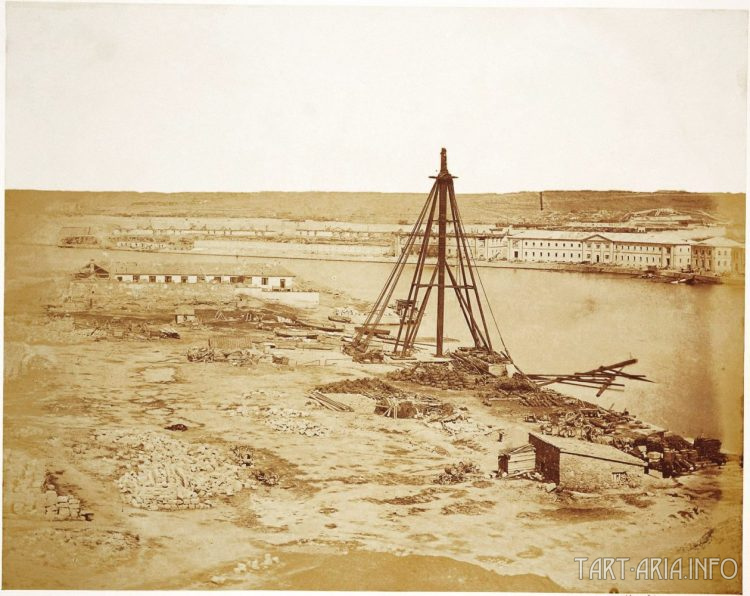
Iron bearings for the masts ironically survived. How can it be explained? Everything is simple – they served as electrically grounded lightning dischargers (lightning rods). Projectiles shot from above mentioned weapons apparently had properties and appearance similar to ball lightnings. If Sevastopol defenders had been equipped with knight armor there would have been much fewer casualties. Unfortunately, very few people survived that slaughter.
However, there was something else. Advance energy technologies of the past were used across the globe, so there were no reason to siege Sevastopol almost a year just to destroy several units of these weapons. The city had another secret, but what was it?
Returning back to official history, why did the city defenders protect Malakoff redoubt til the very end? What strategic value did it have?
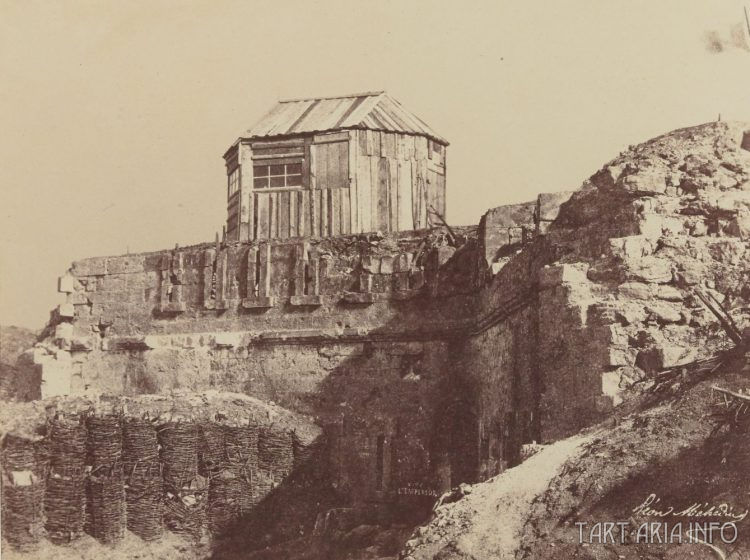
As you can see in the photo, by the end of siege there was nothing unusual about it. A common stronghold, which is sometimes also called "redan". If Allied forces needed a strategical height for city bombing, they could have easily captured the northern fort, which has perfect positioning for shooting the bay.
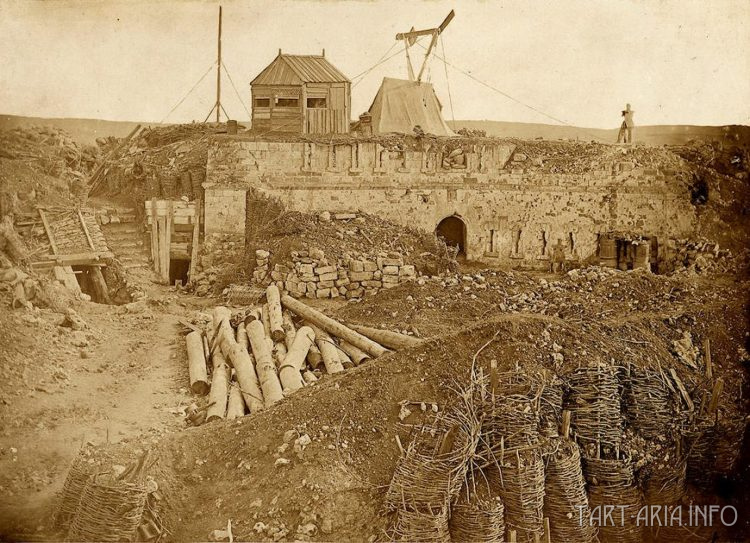
This photo shows everything left from Malakoff redoubt upon its defeat. Here we can see that most debris were taken out and some wooden house, erected on the top. The purpose of that house is unknown. Nowadays, the whole place is turned into a memorial. But what secret did it keep originally?
To find the truth, let’s see again what official history has to say about this (excerpt from Wikipedia):
"Until 1784 most of the fortifications around Sevastopol were dedicated to the protection of the harbour entrance, the city itself and its naval base and were positioned close to these features. The construction of fortifications in the surrounding hills had been planned as early as 1837, but at the time of the battle only basic facilities and roadways had been completed on the north side of the long, westward-facing bay. To the south the central anchor of the defence system was the Malakoff-Kurgan ridge. Situated about 2.5 miles (4.0 km) southeast of the city, it consisted of a two-story stone tower of limestone on which the Russians had placed five heavy 18-pounder cannons at the beginning of the siege.
There is some mystery surrounding this tower. Although it is known that the tower was built some time before the start of the war, the historical records do not show exactly when this occurred, and no mention of this is made in the contemporary descriptions of the siege itself. Additionally, there are different spellings and translations into or from Russian, including Малахова башня. What is known is that the tower was originally built or expanded by Sevastopol merchants and then later taken over by the Russian Navy. The tower had a diameter of about 14–15 metres (46–49 ft) and a height of 8 metres (26 ft). In its centre the battery known as "Lunette Kamchatka" was placed. This was a smaller fortification that was designed to protect several artillery pieces."
What stone tower are they talking about? Information from wiki seems to be incomplete. The french once started a production of cakes named Malakoff but I don’t think it has anything to do with the case (one could have thought that it was made in the shape of that tower). If you look at most of the prints depicting the battle for Malakof redoubt, you won’t see anything except bunch of soldiers, fighting on a hill. But some prints eventually gave out the truth.
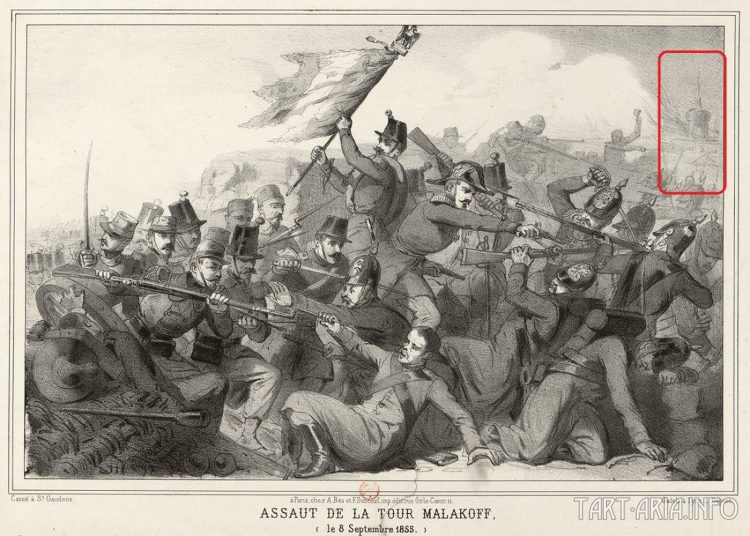
Did I see something in the background or it’s just my eyes playing tricks on me?
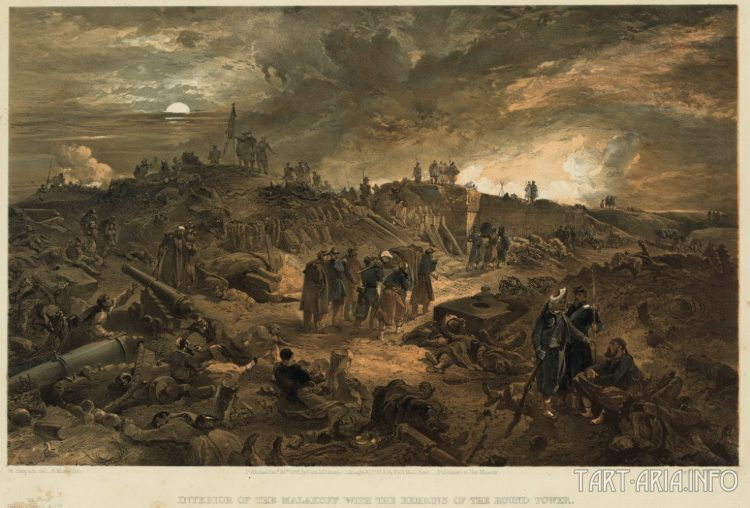
This print is quite realistic. You can see the redan but there is no tower. However, it is the title that we should look at: “Interior of the Malakoff with the remains of the round tower”. This redan is probably what remained of the tower. Let’s proceed further.
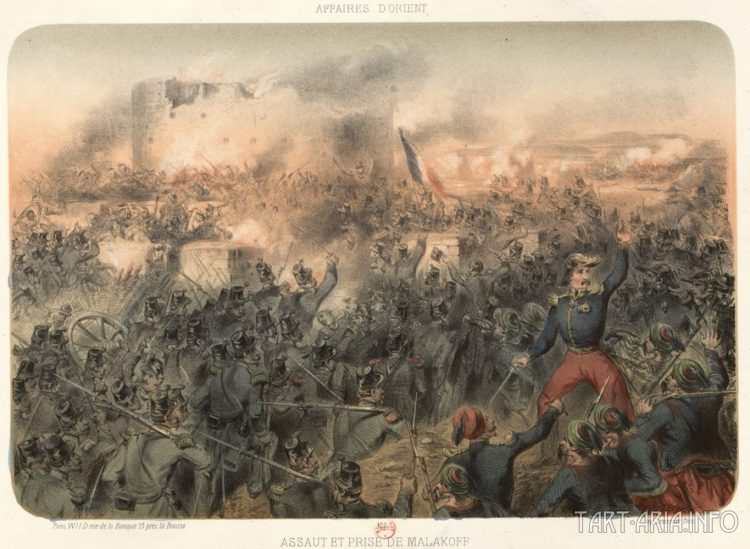
Here we finally see some kind of tower, but already damaged to some extent.
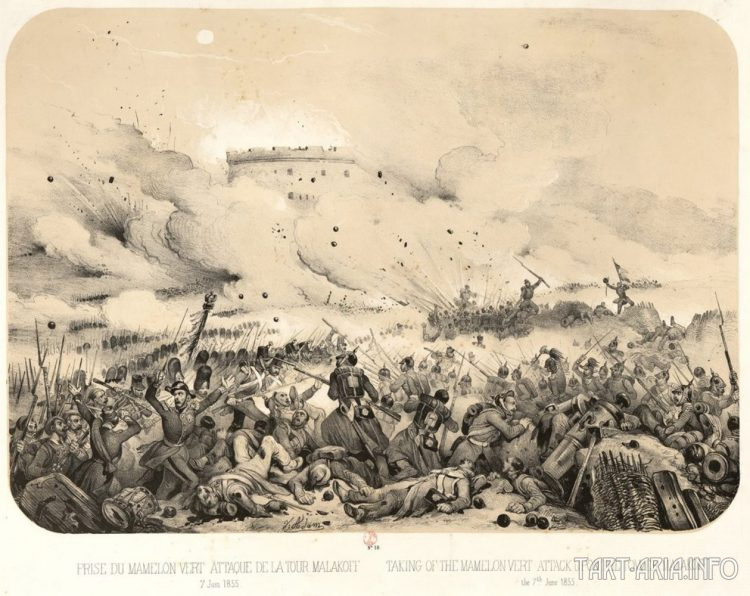
In this print of another author we can see the tower the way it looked originally.
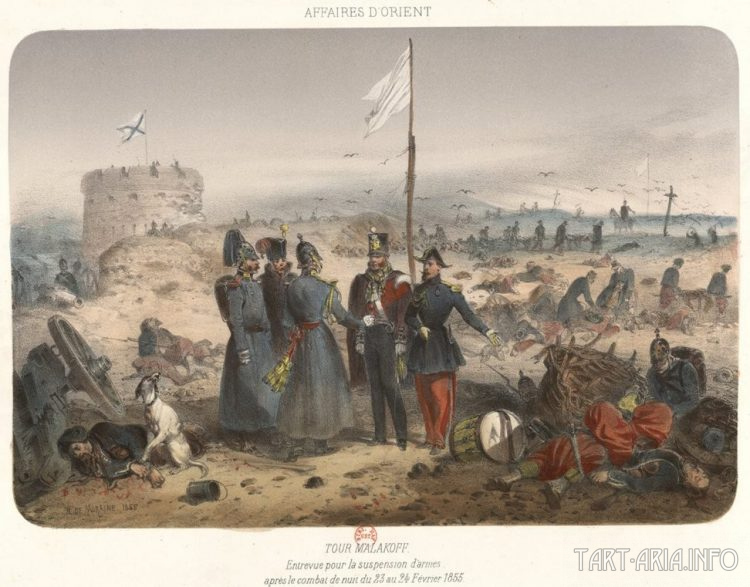
Another print with a clearer look.

This print is taken from an album of illustrations by William Simpson. There we see more precise details of the tower that apparently stood on a giant notched wall. Unfortunately, in this print the tower is already broken. I couldn’t find any more pictures on the internet, but even these were hard to find. Why was it so important to erase details of this tower from history?
My further research revealed that the Malakoff tower had already been partially destroyed in 1854 (prior to the active combat actions). Currently it is impossible to find out why it happened. Maybe it was an act of sabotage, or maybe there were some other combat actions that we know nothing about.
Curiously enough, the “manipulators” of history couldn't foresee a fact that architectural objects could be copied and reproduced in other parts of the world. Luckily for us, there is another tower, similar to the one that used to stand on the Malakoff redoubt, which is located in a city called Jena (Germany), on a hill named (guess what) – Malakoff. The image was found in an unknown digital archive.
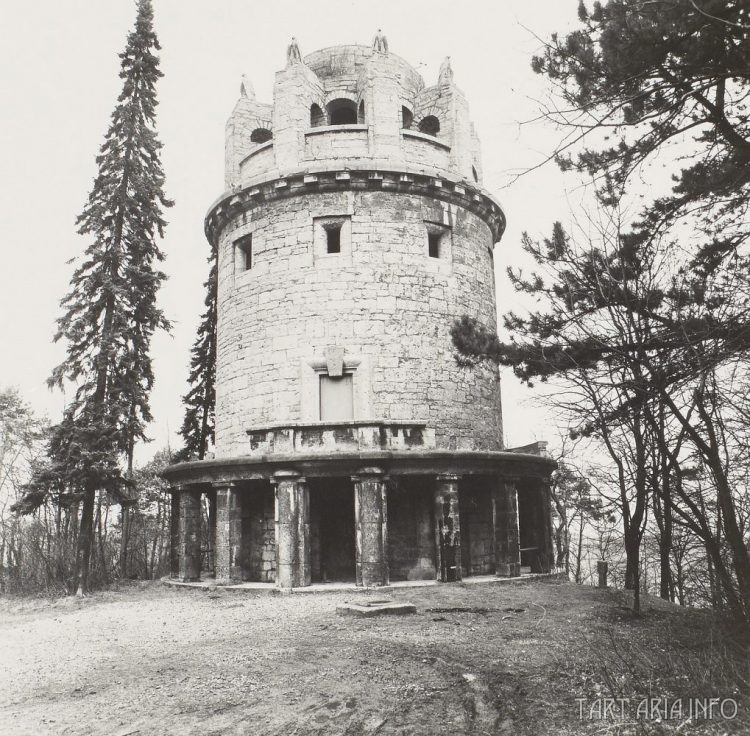
In 1896 the tower had the same name as the hill. Later on, it was renamed to “Kaizer tower”. It should be noted that there are numerous “Kaizer towers” in Germany (at least 100). But do you really think German’s chancellor needed so many towers made in his name? It was just convenient to name them this way from a historical point of view. Most probably, this tower was erected as a commemoration memorial related to the events in Crimean War. It is even possible that Germany at that time was not at the winners’ side. One theory claims that Germany (as well as Austria-Hungary) was an ally of Russian Empire in the 19th century.
Now look closer at the German Malakoff tower and the one depicted in Crimean war prints. I have enough reasons to believe that the German tower is an exact copy of the Sevastopol tower, excluding some minor cosmetic details as well as the lack of dome (according to my research, such constructions tend to have domes on their tops).
Ok, the towers could be same, but how is it related to lost energy technologies, you would ask? Let’s return to the images depicting Sevastopol defense.
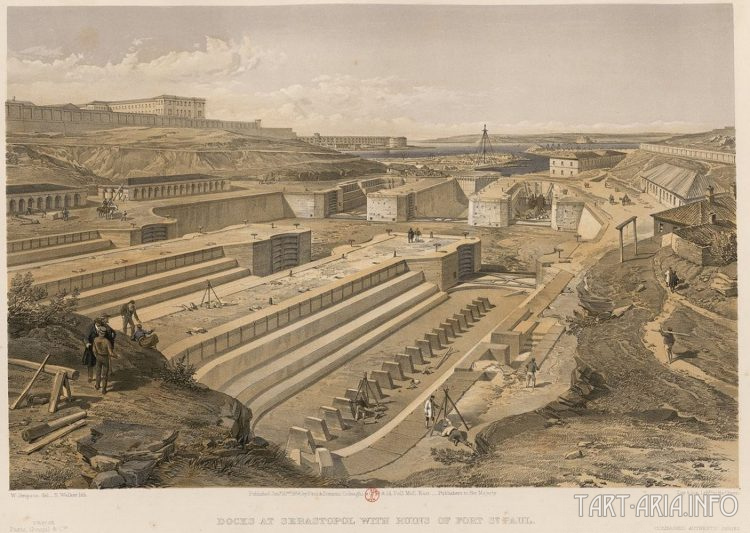
The image depicts dry docks for small ships. An author apparently copied it from a real photo, retouching some details. You can compare it yourself (another photo from J. Robertson’s collection):
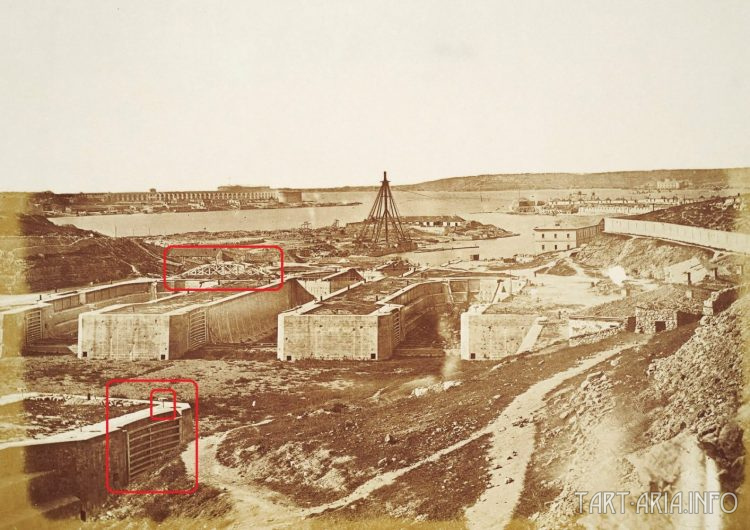
Pay attention to the arched framework (upper highlighting), it is almost intact. I guess the whole construction is grounded, and its upper part is just a superstructure. You can see the same detail copied in the image, as well as many other elements. Even the hatches and water control units survived and can be seen in the photo/image. The entrance to dry docks is located on the right side of the arched framework. The dirt that we see in the right half of the photo had fallen there shortly before the photo was taken, and apparently had fallen from debris of a destroyed building that once stood on the upper hill. But how did water use to get into these docks?
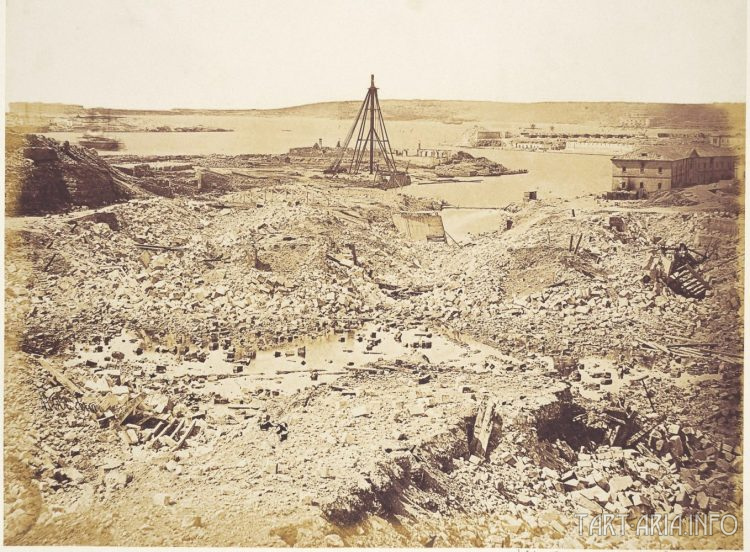
This photo was made by the very same J. Robertson. The arched framework and mast holder survived, but the whole facility is destroyed. What could it mean?
Apparently, J. Robertson gradually captured all stages of Sevastopol’s destruction. At first, he photoed the city the way it looked before combat actions, and then, after the destruction of infrastructure. Best proofs for the queen that Allied forces’ mission was complete. Concerning the destruction of dry docks, it was necessary to make it useless (in case someone would decide to restore its functionality one day). This facility after all, had been crucial for Sevastopol. Without it, the city could not be used as a naval base.
We still haven’t found an answer to the question – how were the docks filled with water? Time to get back to Malakoff redoubt and look at the modern satellite map.
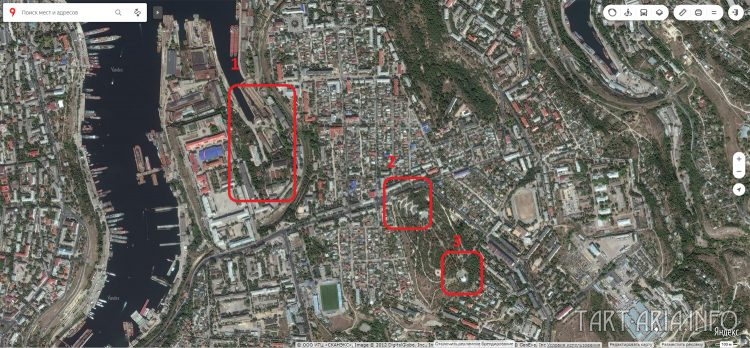
№1 is a former location of docks. Even nowadays there are few constructions. №3 is a former location of Malakoff redoubt (though it occupied a larger area). №2 shows us remains of some buried cascaded structure, oriented towards the docks. I hope now it becomes clear. The Malakoff redoubt’s tower was nothing else but a hydrotechnical facility, which played a key role in the process of filling the docks with water. Similar device is described in this article. Without it the docks could not function, that’s why it was guarded till the very end.
Let’s return to one of the previously shown prints and look closer at it.
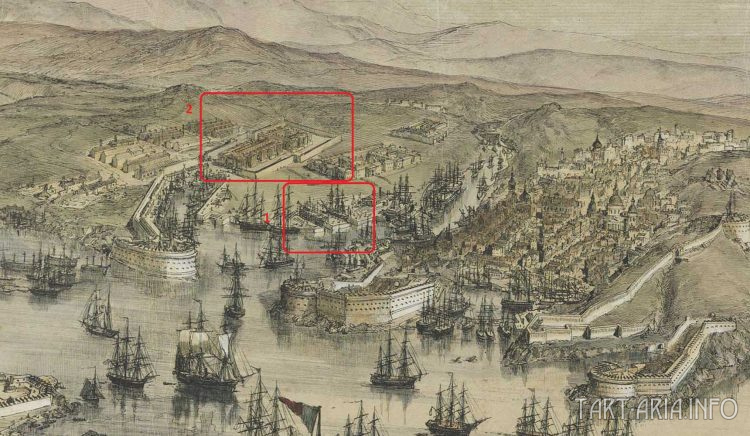
№1 is a simplified depiction of docks that we reviewed previously. But what is depicted in the area marked №2? It looks like another dock but for bigger ships. Ships entered it via a bay that currently does not exist. Nearby some shipbuilding facilities can be seen. All of them apparently were targeted for destruction.
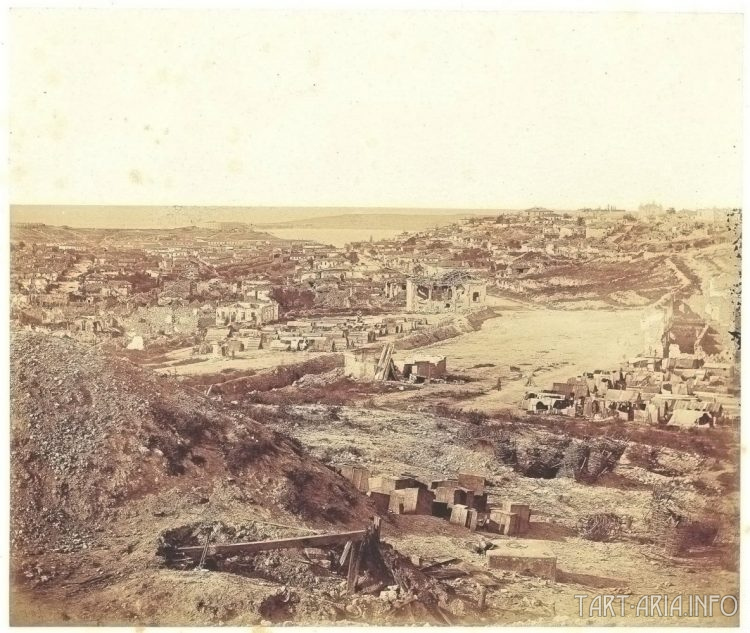
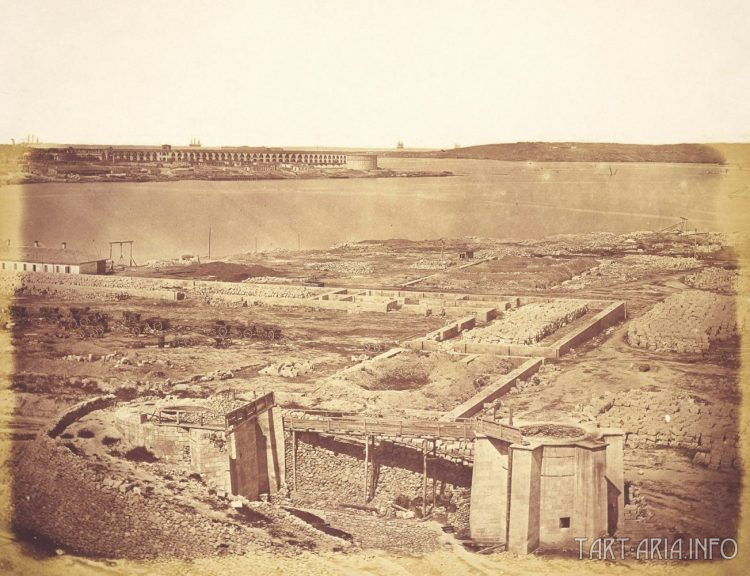
As you can see, most facilities were turned into ruins. The Malakoff tower, being the most crucial element, was wiped out and forgotten. Nowadays Crimea faces serious problems with water supply – underground water seems to be absent. You may have already guessed that this problem could have never existed, if all those hydrotechnical facilities had not been destroyed.
Time to sum everything up.
The Crimean war, as well as any other military clashes near the borders of Russian Empire that happened during mid 19th century, had a quite tangible underpinning. Their target was currently forgotten (forbidden) energy technologies, which continued to exist after some little-known global disaster. Russian Empire was one of the most affected territories after that disaster. Various nations used this situation for their benefit and sent military formations to Russian territory. I will figuratively call them «Allied forces» (or the first international union). Russia managed to defend itself from this first union’s attack. It was the time when Crimean war happened. The result of this war apparently sit well with all sides.
The Sevastopol defense was one of the most vivid stages of that war. No other city saw such intense and long fights as those unfolded in Sevastopol (at least there is no record of such). The main target of that conflict was Sevastopol’s naval base, which functioned using old energy technologies. This technology was very unfitting for the new world order.
Russian Empire was not interested in using this technology either. All facilities (which used this technology) that managed to survive and even continue its work existed independently, rather contrary to than thanks to the government policy. Russian Empire was just another dependent colony of backstage rulers, so it shared their agenda concerning the use of old technologies.
So when the late 19th century industrial revolution happened, all remains of old technologies had to be destroyed and hidden completely, or else, they could have gotten out of control. But this time, there was no need in sending allied (international) armed forces there. Another «international» force appeared «at the right time» and finished the job using the hands of semi-literate citizens.
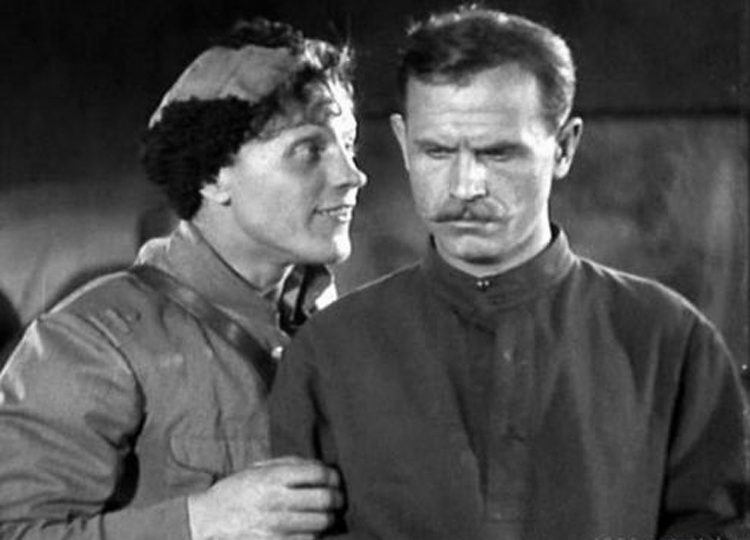
The readers may ask a reasonable question – what happened to other facilities in the Russian Empire that used similar energy technologies? In Baltics for instance? It is hard to tell for sure. I can only assume that some were captured and dismantled quietly, without sieges and fights. However, I don’t think that we’ll ever find out the exact truth. Even though there are plenty of historical materials covering the 19th century, it is still a very disputable and vague time in our national history. Nevertheless, the plan of hiding the truth has always been carried out, and still is.










